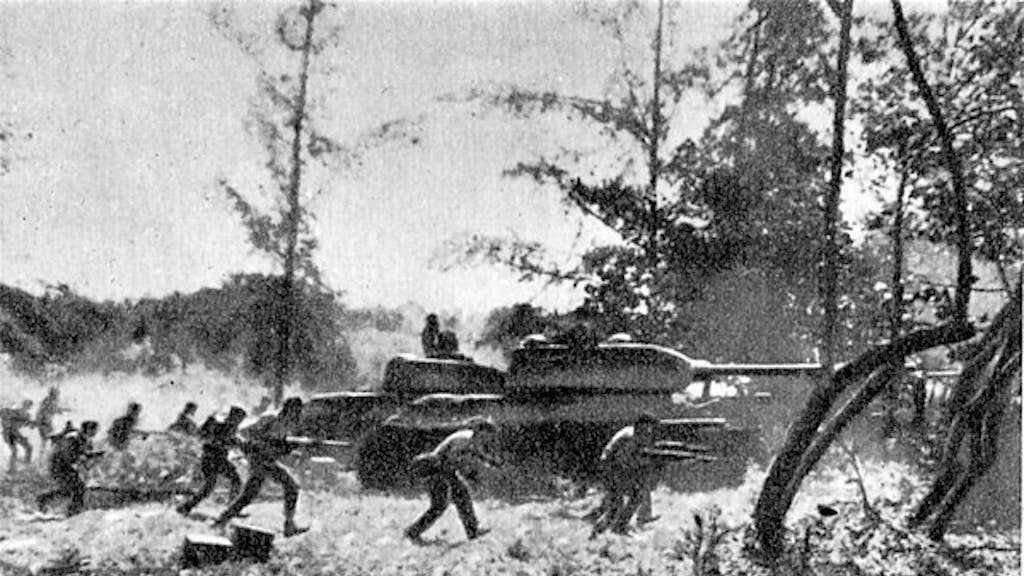8 Members of the Alabama Air National Guard fought at the Bay of Pigs invasion

Counter-attack by Cuban Revolutionary Armed Forces supported by T-34 tanks near Playa Giron during the Bay of Pigs invasion, 19 April 1961.
SUMMARY
In April 1961, 1,500 Cuban exiles landed on the southwestern coast of Cuba. Just two years prior, rebel leader Fidel Castro took power in Havana after years of revolutionary combat. Unlike revolutions on the island in the past, Castro was a communist, and his revolution nationalized American businesses, which included industries like oil, sugar and coffee. The U.S. government was not pleased.
President Eisenhower enacted an embargo on Cuba while the CIA began funding Brigade 2506, an armed insurgency group dedicated to overthrowing Castro and reinstating democratic rule in Cuba. By the time the invasion was ready, it consisted of 1,500 exiles. CIA B-26 bombers hit Cuban airfields two days before the invasion. It did not go well for the exiles.
On April 17, 1961, five battalions of troops landed at the Bay of Pigs, backed by Cuban pilots. It overwhelmed the local militia, but Fidel Castro took personal command of the counterattack. The plan required support from U.S. naval and air forces, but when the world learned what was happening, President John F. Kennedy withheld that support. All the Cuban exiles had for air cover were Cuban pilots.
On the last day of the invasion, April 20, Cuban pilots were exhausted from their efforts. With their democratic fighters dying on the ground, four pilots from the Alabama Air National Guard and four enlisted crew members volunteered to take over in four of the Cuban exiles’ bomber aircraft.
The Alabama National Guard had been part of the operation for a long time before the actual Bay of Pigs invasion. The governor of Alabama had approved the use of National Guard personnel to assist the CIA in 1960. It was the Alabama ANG who trained the Cuban exiles to fly and fight in the Douglas B-26 Invader bomber. Alabama was the last state guard who was flying the B-26.
Because Kennedy had restricted the number of bomber aircraft that could attack Cuba before the invasion, only half of Castro's air force was destroyed in the initial attack. The rest of the air forces were able to destroy the fuel and supplies for the invasion that were waiting offshore aboard merchant ships after the initial bombing run.
When the Bay of Pigs invasion came, the Cuban exiles were ambushed by Castro’s air forces. They lost five of their 16 bombers on the first day. When they returned to the secret airbase in Nicaragua, Alabama guardsmen repaired, refueled, and rearmed them before they made the six hour flight back to Cuba. With a manpower shortage in the air, Kennedy finally relented and allowed American pilots to assist.
When the CIA gave the green light to the Alabama guard, eight of them stepped forward to volunteer. Maj. Billy “Dodo” Goodwin, led the group with pilots Joe Shannon, Riley Shamburger, and Thomas Willard "Pete" Ray and Alabama crewmembers Leo F. Baker, Wade Gray, Nick Sedano, and James Vaughn. When the American-run planes began their approach, they were swarmed by Castro’s fighters. Riley Shamburger and his crewmember Wade Gray were shot down over water. Their bodies could not be recovered.
Ground fire from Cuban gunners brought down pilot Pete Ray and crewmember Leo F. Baker. They survived their crash landing, but were killed by Castro’s Cuban revolutionaries in a firefight after landing. The remaining aircraft left the area. Later that same day, the invasion ended in failure. The invaders that survived were held for ransom until 1963. Pete Ray's body was held in Cuba for another 17 years.
SHARE
